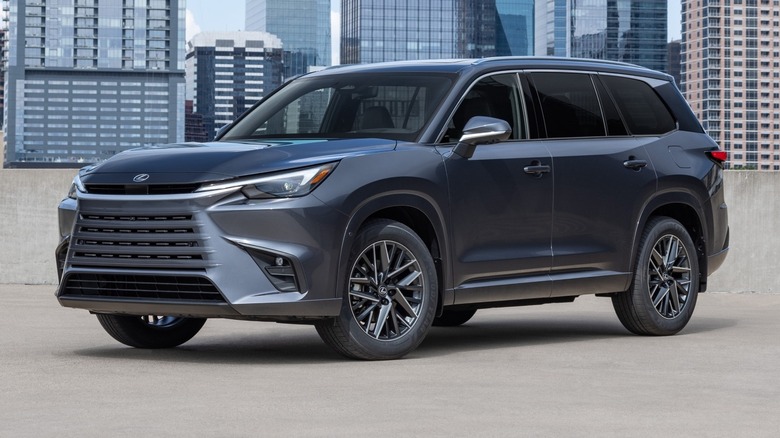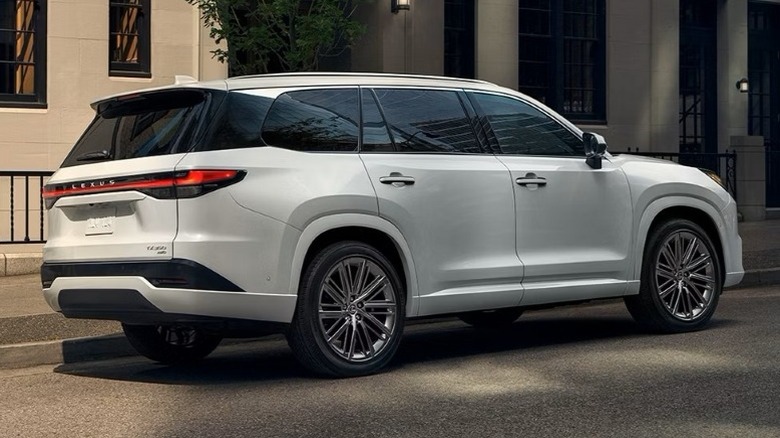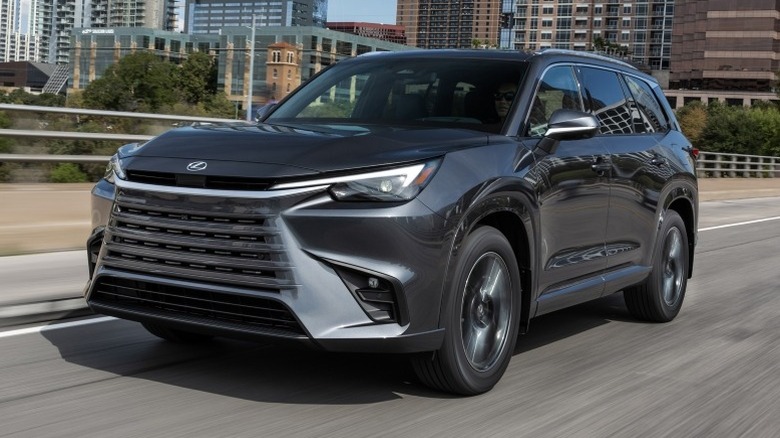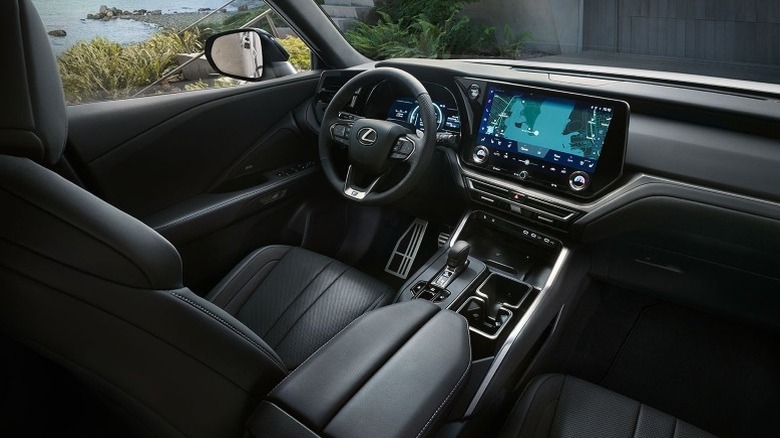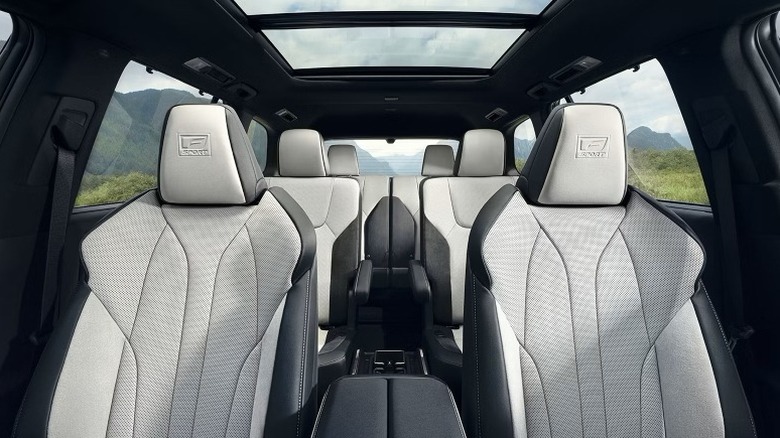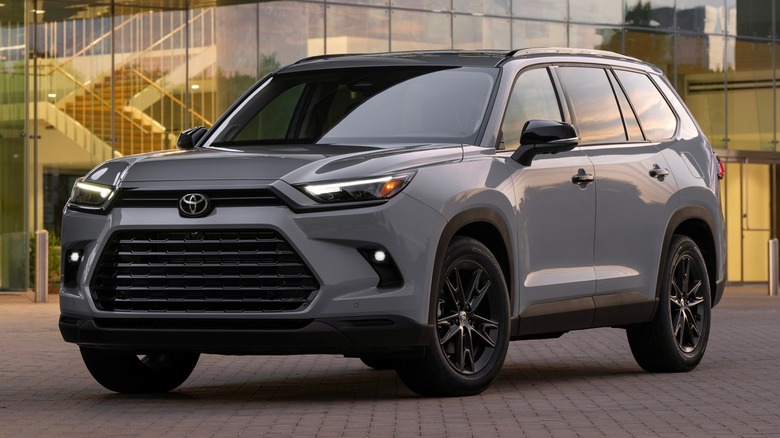Is The Lexus TX The Same As Toyota's Grand Highlander? How The SUVs Compare
The Lexus TX and Toyota Grand Highlander were both introduced for the 2024 model year. But they're already a familiar part of the American car market, and their popularity has soared to the point that they're now among the go-to options for consumers seeking three-row SUVs. However, if you've ever looked at their spec sheets, you'd be forgiven for thinking that the Lexus TX and Toyota Grand Highlander are more or less the same model. That's because the two are indeed related.
Both SUVs are manufactured at Toyota Motor Manufacturing Indiana (TMMI) in Princeton, Indiana. They're also based upon the same GA-K platform shared with the Lexus RX, NX, ES, Toyota RAV4, Highlander, Camry, and several other models. Not to mention, they ride on a similarly sized 116.1-inch wheelbase, are dimensionally identical in width and height, and share a common base engine.
Despite their many shared similarities, there's no confusing the two externally, as each still remains unique and distinctive, especially when viewed from the front, where the Lexus TX boasts a more imposing presence compared with the Toyota Grand Highlander's understated look. Beyond the exterior, there are certain features that set the Lexus TX and Toyota Grand Highlander apart, too. And so to give you an idea of just how different they are, we've compared the two in terms of their trim options, prices, performance, interior features, technology, and cargo space.
The Lexus TX is considerably costlier than the Toyota Grand Highlander
While the TX and Grand Highlander both belong to the same family of Toyota unibody SUVs, Lexus' luxury leanings mean that its cars will typically cost more than their Toyota counterparts. If you're considering the Lexus TX, the overall range consists of four trim levels: the standard TX 350, Premium, Luxury, and F Sport Handling. The Toyota Grand Highlander, meanwhile, is available in five grades of LE, XLE, Hybrid Nightshade, Limited, and Platinum.
That said, the Lexus TX is a lot more expensive in the base trim, with the TX 350 costing $56,490 (MSRP), which makes it $15,630 costlier than the $40,860 Toyota Grand Highlander LE. From there, each trim level sees the base MSRP increase as you move up through the grades, with the TX 350 Premium starting at $59,290, the TX 350 Luxury at $61,640, and the TX 350 F Sport Handling commanding $65,760.
Lexus also offers hybrid and plug-in hybrid options, starting with the TX 500h F Sport Performance Premium, which begins at $70,010. The TX 500h F Sport Performance Luxury and TX 550h+ Luxury start higher at $73,160 and $78,560, respectively. Being the value champion it is, the Toyota Grand Highlander doesn't get as expensive. The XLE is the next step up from the base LE, and it starts at $43,630 — $580 less than the $44,210 Hybrid LE — while the Hybrid XLE is priced from $45,380.
To drive off in the Grand Highlander Hybrid Nightshade, you'll need at least $52,610, while the Limited and Hybrid MAX Limited will set you back a minimum of $48,360 and $54,690. Pricing for the Grand Highlander Platinum starts from $54,045 for the gas-powered model, rising to $58,775 for the top-level Hybrid MAX Platinum grade.
The Lexus TX produces more power than the Toyota Grand Highlander
Although both the Lexus TX and the Toyota Grand Highlander are powered by the same turbocharged 2.4-liter four-cylinder engine, they make two different power outputs. In the Lexus TX, the powertrain is tuned to generate 275 horsepower and 317 lb-ft of torque. That's 10 more hp and 7 extra pounds of torque over the Toyota Grand Highlander's base output of 265 hp and 310 lb-ft, resulting in a 0-60 mph time of 8.0 seconds in TX models with front-wheel drive; AWD TX variants do 0-60 in 7.8 seconds, according to Lexus estimates. Toyota's claimed figure for the four-cylinder gas engine is 7.5 seconds, meaning the gas-powered Grand Highlander is quicker than the equivalent Lexus TX on paper. In hybrid guise, the TX 500h combines the same 2.4-liter turbo inline-four mill above with two electric motors to generate 366 total hp and achieve a 6.1-second 0-60 time.
The plug-in hybrid TX 550h+ Luxury, meanwhile, features a 3.5-liter V6 engine and two electric motors that combine to produce 404 horsepower and hustle it to 60 mph in 5.9 seconds. With the Grand Highlander, you have a choice of two hybrid engine options. The less potent variant is centered around a 2.5-liter four-cylinder gas engine that works alongside two electric motors to generate a combined 245 horsepower and manage zero to 60 mph in 7.8 seconds. The most powerful Grand Highlander engine is the 362-hp Hybrid MAX, which Toyota says will accelerate the midsize SUV from zero to 60 mph in 6.3 seconds. Both the Lexus TX and the Toyota Grand Highlander can tow up to 5,000 pounds.
The Lexus TX offers a plusher and more premium cabin in the base trim
The interior is perhaps where you would expect the Lexus TX to feel the furthest apart from the Toyota Grand Highlander, and the Japanese automaker did just enough to ensure that they look and feel very different. For example, while the TX 350 comes standard with synthetic leather upholstery, the Grand Highlander features cloth upholstery. The base TX 350 also offers a heated, leather-wrapped steering wheel and heated seats for the driver and front passenger, which the Grand Highlander LE lacks.
Tech-wise, the Lexus TX has a standard 14-inch touchscreen, a 12.3-inch digital gauge cluster, a wireless smartphone charger, wireless Apple CarPlay and Android Auto, wireless device charging, Wi-Fi hotspot, and a 12-speaker audio system. With the Toyota Grand Highlander, you get a 12.3-inch touchscreen alongside a 7-inch digital gauge cluster, wireless Apple CarPlay and Android Auto, Wi-Fi hotspot, and a six-speaker audio system.
That said, moving up through the trims bumps up the Grand Highlander's interior offering, with the XLE grade adding niceties such as a wireless smartphone charger, a leather-wrapped steering wheel, heated front seats, and synthetic leather upholstery. Go all the way up to the range-topping Platinum grade, and you'll have you and your passengers basking in luxuries such as a panoramic moonroof, heated and ventilated front and second-row seats, as well as genuine leather upholstery. Second-row fold-down captain's chairs, memory settings for the driver's seat, a 12.3-inch digital gauge cluster, and an 11-speaker JBL sound system also come standard.
Opting for the top-level Lexus TX 550h+ Luxury nets you the superior semi-aniline leather-appointed seating, second-row captain's chairs, a 21-speaker Mark Levinson surround sound system, as well as memory settings for the driver's seat, steering wheel, and exterior mirrors, to name a few.
The Toyota Grand Highlander hauls more people than the Lexus TX
The Lexus TX and Toyota Grand Highlander are both equipped to cater to families, but the Grand Highlander comes with eight seats as standard, while the Lexus TX offers seven seats. If you opt for the second-row captain's chairs, the seating capacity reduces to seven for the Grand Highlander and six for the Lexus TX.
Headroom and legroom figures are almost identical, with the base Grand Highlander LE offering 41.5 inches of headroom and 41.7 inches of legroom up front. The second row provides up to 40.2 inches of headroom and 39.5 inches of legroom, while the third row has 37.2 inches of headroom and 33.5 inches of legroom.
With the base Lexus TX 350, there's a slight reduction in front headroom and legroom to 41.4 and 41.6 inches, respectively, whereas second-row occupants get 40.1 inches of headroom and 39.5 inches of legroom. The TX's third-row figures are similar to what you get in the Grand Highlander, at 37.2 inches of headroom and 33.5 inches of legroom.
Predictably, there's little to separate the two in terms of cargo capacity, too, as you get a maximum of 97 cubic feet in the Lexus TX and 97.5 cubic feet in the Grand Highlander. You also get a useful 20.2 cubic feet of room in the Lexus TX behind the third row; fold that down, and you'll have 57.4 cubic feet to play with. The Grand Highlander, for its part, claims 20.6 cubic inches when all seats are in place and 57.9 cubic feet when you fold down the third row.
Which should you buy between the Lexus TX and Toyota Grand Highlander?
The Lexus TX and Toyota Grand Highlander both have appeal as three-row SUVs. However, if you have a big family or plan to carry many passengers often, you may find greater favor with the Grand Highlander than the Lexus TX, due to its bigger seating capacity. The Grand Highlander is also a top choice if you just want something that's reliable and sensibly priced, or are looking to avoid costly repairs and high maintenance bills, as it is one of the Toyota cars with cheap maintenance costs.
That being said, the Lexus TX makes a lot of sense if you care more about the badge, power, prefer a plug-in hybrid, or want to spend time in some luxury. It offers opulent cabin materials with excellent infotainment tech that adds to its appeal. In addition, SlashGear's review of the Lexus TX found it to be very comfortable to drive while sacrificing neither practicality nor passenger wellbeing — which should be welcome news to fans of the Lexus RX L three-row who have always yearned for something with a relatively generous amount of room in the third row. For context, the 2022 Lexus RX 350L offered 34.8 inches of headroom and 23.5 inches of legroom in the third row. This makes the TX's 37.2 inches of headroom and 33.5 inches of legroom a significant improvement.
